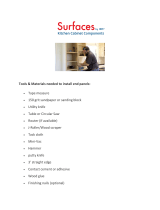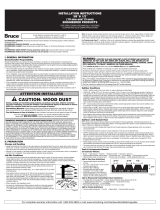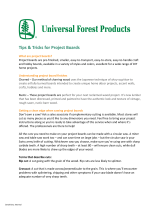
TIPS + TRICKS
Searching for more? Visit handprintmade.com/tips-tricks
SAWS
The most versatile and aordable saw is a circular
saw with a combination blade. Beginners will
appreciate using just one blade for both ripping
and cross cutting.
Jig saws (aka saber saws) cut in an up-and-down
motion and oer much more control. Use a jig saw
for making complex cuts or more intricate designs.
HAMMERS
Small nails are easier to drive with a shorter, lighter
hammer (8-16 oz.) with a small, flat head. A longer
handle delivers more power, but it’s harder to control.
For more durability and comfort, we recommend a
fiberglass or composite handle.
Choosing Tools
POWER DRILLS VS. SCREWDRIVERS
A cordless power drill and a screwdriver (manual,
electric, or power) will all fasten a screw. But for
predrilling holes and driving screws, pick a drill with
either two speeds or a variable speed. High is for
drilling, low is for screwing.

Woodworking Tips
SAWING
As they say, measure twice, cut once.
For the cleanest cut, consider these tips:
• Use a new, fine-tooth, 80-tooth or more, carbide,
combination sawblade.
• Score your cutline first using a straight edge and
a sharp blade, like a utility knife or razor blade.
(The cutline is the line the sawblade will travel.)
When measuring, add the width of the sawblade
to your mark.
• Give extra support to the wood fibers along
the cutline by running a piece of painters’ tape
over it.
• If an extra-clean cut is important, securely
clamp a second, thin piece of scrap wood to
the bottom of the piece you’re cutting.
• Frayed edges can be easily cleaned up with
some quick sanding. A badly chewed edge can
be repaired with wood filler or woody putty
as needed.
SANDING
• A smooth, ready-to-finish surface is accomplished
using a series of increasingly finer grit sand-
papers. Start with medium-fine grit like #120,
progress to #150, and end with #180. Note that
skipping a grit can leave scratches too deep for
the next grit to remove.
• Sand evenly and in the direction of the grain.
• Don’t oversand – you could potentially seal
the wood so tightly it won’t absorb finish.
• Be careful if using an electric sander (palm
or orbital) on veneer faces. They’re easy to
accidentally sand through with too much power.
• Wipe wood with a damp cloth to remove dust
after sanding.
• Don’t sand wood fiber panels (MDF, particleboard,
hardboard). These wood products already have
smooth surfaces, but when sanded, they also
create a tremendous amount of very fine saw-
dust that can irritate eyes and lungs.

DRILLING
Predrilling screw holes is always recommended.
It helps prevent splitting, gaps, and fastening at
an o angle.
• For the strongest, longest-lasting hold, predrill
holes slightly smaller than the screws you’re using.
• When you need to avoid drilling all the way
through a piece of wood, wrap a piece of tape
around the drill bit to mark the depth you want to
stop and reverse out.
SCREWING
• To avoid slipping o, stripping the screw, etc.,
hold both the screw and the drill as vertically
straight as possible and pull the trigger with
slow, even pressure.
• Use flathead wood screws if you want the
head flush with the surface of the wood.
• Avoid fastening into knots.
GLUING
• Use wood glue – also called polyurethane glue -
not white school glue or a glue gun.
• Before applying glue, wipe wood with a damp
cloth to remove any dust or particles that could
prevent a tight bond.
• After applying glue, clamp pieces together and
allow to dry for at least 30-60 minutes. Dry for
24 hours if there will be any stress on the joint.
NAILING
• To lessen the chance of accidentally splitting your
wood, choose the thinnest nails possible that will
still provide adequate holding power.
• Avoid nailing into the end grain, especially with
oversized nails.
• Predrilling is usually unnecessary when nailing
unless you’re using hardwood, very thin material,
or you need to nail close to the end grain.
Fastening Tips

PLYWOOD EDGES
• Wood filler or wood putty is perfect for the
occasional void commonly found in any
plywood. Be sure to follow manufacturer’s
instructions for use.
• If you want to hide the plies on the edges of
your plywood, apply edge banding (available
in a variety of widths and colors/species), or
cover with a thin strip of natural, solid wood.
PAINT
• For the cleanest results, paint each piece of wood
after cutting, drilling, sanding, and wiping down,
but before assembling your project.
• A base coat/primer will allow for better paint
coverage and less spots where the grain
shows through.
• A clear topcoat of any water-based polycrylic
adds a protective finish and/or your desired
level of glossiness.
STAIN
• For more even coverage, use a prestain.
• Apply stain using old rags or towels, or choose
a brush made specifically for stain.
• End-grains (areas where the wood has been cut
against the grain) tend to soak up more stain than
other areas. Give end-grains an extra sanding to
tighten the pores and lessen the overabsorption.
• The finer the grit of the final sandpaper you use,
the lighter the stain color will be. The coarser the
sandpaper, the darker the color will be.
• Don’t stain wood fiber panels (MDF, particle-
board, hardboard). These panels are susceptible
to moisture and expand when wet. Additionally,
without a natural woodgrain, they fail to absorb
stain evenly.
Finishing Tips
-
 1
1
-
 2
2
-
 3
3
-
 4
4
Ask a question and I''ll find the answer in the document
Finding information in a document is now easier with AI
Related papers
Other documents
-
American Pro Decor 5APD10626 Installation guide
-
 Surfaces BASEEPOAK2436 Installation guide
Surfaces BASEEPOAK2436 Installation guide
-
DAP 7079800543 Operating instructions
-
Shaw HD56702002 Installation guide
-
Shaw DH87002000 Installation guide
-
GREAT PLANES Rapture 40 User manual
-
 Bruce EAHHD75L402 Installation guide
Bruce EAHHD75L402 Installation guide
-
RIDGID TS3650 User manual
-
Shaw DH83300941 Installation guide
-
 UFP-Edge 375789 User guide
UFP-Edge 375789 User guide










